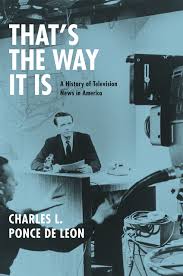That’s the Way It Is: A History of Television News in America
- By Charles L. Ponce de Leon
- University of Chicago Press
- 352 pp.
- Reviewed by Jonathan Ebinger
- July 10, 2015
Recalling a medium's glorious past and somewhat inglorious present.

The history of television news in this country is not a small topic. In many ways, it is a history of America. Of who we are. And what we’ve done. Or at least what we’ve done over the last half of the 20th century. And then some.
That’s The Way It Is walks us down this memory lane. It covers most of the major stories over the years. But it’s not as much a book on TV News as it is an assessment of the news. It reminds us about the business of news on television. And it is a business.
So whether it’s the advent of cable, the prominent role of network anchors, or the powerful position that local news still maintains, we are cycled back with regular reminders of the role of the public, and the market, in helping decide what is presented to us each day on air.
Cal State Long Beach historian Charles L. Ponce de Leon dips into these topics, among others, in this readable history. Though he regularly cites the Federal Communication Commission as a significant influencer on how television news is delivered, he reminds us that news is not so much a public trust as a private business.
And with the exception of PBS, about which he spends a chapter documenting the history of public broadcasting, he delivers on that reminder, noting how each network would jockey to get ahead of another. Or how CNN would come to compete not only with ABC, CBS, and NBC, but with the likes of MTV and ESPN, as well. (A final chapter that leads into the role of the internet tries to extend this further, but a history that attempts to discuss the future is a history best left unwritten.)
In the appropriately titled chapter “News you can use,” we learn how the network-news model, one that still exists, evolved from once being in the hands of a few men based in New York to what we have today, with corporate ownership and stock value in play.
Regardless of how one views television news, we understand its role in our consciousness. Whether you’re one of the few still watching an evening newscast, or among those who sustain local news as the most popular news-delivery medium in the country, or perhaps someone who considers news-parody programs more than mere entertainment, you call upon TV news as the baseline for how you access visual news media. There are certainly other ways to view content, but TV news still processes the media and presents it to us in a relatively palatable way.
And that’s precisely how Ponce de Leon presents the past 70 years of visual media. Whether it’s the early days, when network news barely reached beyond an elite few in New York City, or the significant role that TV News had at political conventions in the 50s, or in covering the civil rights protests and Vietnam War of the 1960s, or the space race…you get the picture.
Television was there, evolving alongside us as we learned to accept the form, and then demanded more from it for our evolving taste.
But tastes change. And by the end of the 20th century, those of us old enough to remember recall the wall-to-wall coverage of a handful of salacious stories. And near the end of the book, it’s a reference to the Clinton-Lewinsky saga that helps bridge us from where news was to where it has been going since.
With it, “The line in the sand…that had begun to blur in the 1980s and early 1990s and was particularly erased during coverage of the O.J. Simpson case — was completely obliterated. The networks, cable news channels, and tabloid infotainment programs now covered the same stories, often in very similar ways. Incipient trends in reporting and production dating back to the 1960s and 1970s, once held in check by the scrupulous exercise of ‘professional news judgment’ and the dictates of the FCC, sprouted and blossomed with alarming speed.”
Today, relatively few in the business would disagree with this dour view. With rare exceptions, it’s harder today to distinguish between media than it once was.
While this is primarily an academic work, complete with extensive footnotes, Ponce de Leon’s research provides us with moments that advance beyond what interests scholars and news producers.
He cites a memo written in the late 1960s by then NBC News President Reuven Frank, calling for TV news to deliver a narrative within which “every news story, without sacrifice of probity or responsibility, display attributes of fiction…structure and conflict, problem and denouement, rising action and falling action, a beginning, middle, and an end.”
Much has changed since the early days of news. Yet the words of Frank ring true. And reading this engaging history reminds us that despite the look of the newscast, or the anchor’s hairstyle, or the length of her skirt, there’s still a common thread that carries us from the black-and-white coverage of the 1950s to the 24/7 full-color, always-live cable coverage we have today.
Jonathan Ebinger is a former network news producer who spent 10 years with ABC News Nightline. He teaches journalism at the George Washington University and hopes today’s journalism students do not repeat the errors of their predecessors.

